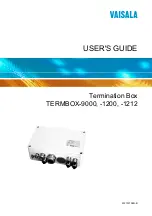
9
Subject to technical modifications
22PDP differential pressure sensor /
Wiring
Wiring
Port wiring
To avoid electric shock or device damage, deactivate the 24 V AC/DC power
supply until all of the connections to the device have been properly made.
Use shielded cables with corresponding core cross-sections for all connections
and do not route the device cables in the same conduit as the cables for supply-
ing inductive loads, e.g. motors. Establish all of the connections in accordance
with national and local regulations.
Undo the union nut of the cable gland at the underside of the housing to guide
the cable through the cable gland and into the housing.
Pull a sufficient length of cable into the housing so that the cable conductors will
be easy to handle and no tensile force needs to be applied to the terminal. Com-
plete the wire connections in accordance with the wiring diagram for the appli-
cable power supply and the output signal type.
To simplify installation, you can remove the terminal from the printed circuit
board by pulling it upward and off the pins on the circuit board.
Ensure correct placement of the terminal after the wiring is completed. The la-
belling of the terminal pins on the printed circuit board must be visible in its en-
tirety and must not be hidden by the terminal.
Connect the DC plus or AC voltage hot side to the +/~ terminal (second pin from
the left). For the voltage output or the power supply, the DC ground or AC supply
common is connected to the
/− terminal (first pin from the left). Do not con
-
nect any power to the AO and ZERO connections, because doing so would dam-
age the device. See Figure 10.
The analogue output is available at the AO connection (third pin from the left).
Check the analogue input of the controller to determine the correct connection
before applying voltage.
When using zero-point calibration with the remote Zero switch, connect it be-
tween ZERO (fourth pin from the left) and ground
/– (first pin from the left).
Screw the union nut of the cable gland on hand-tight after completing the wiring.


































